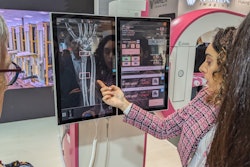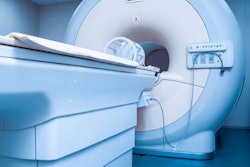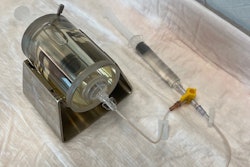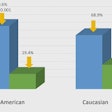A scientific poster on cardiovascular disease (CVD) risk prediction using fat-enlarged axillary nodes visualized on screening mammograms won the Summa Cum Laude Award at the 124th American Roentgen Ray Society (ARRS) annual meeting.
Produced by Jessica Hitchcock, MD, and researchers from Dartmouth Hitchcock Medical Center in New Hampshire, the poster demonstrated how fat-enlarged nodes may be associated with high CVD risk, type 2 diabetes, and hypertension. In the future, this work could improve risk stratification without additional cost or additional testing.
 Jessica Rubino, MD.
Jessica Rubino, MD.
“Fat-enlarged axillary lymph nodes visualized on screening mammography may increase the ability to identify women who would benefit from CVD risk reduction strategies and more intensive risk assessment with coronary artery CT," Rubino said in a statement from the ARRS, adding that the results support further investigation of fat-enlarged lymph nodes, “particularly with studies leveraging AI evaluation of mammographic fat-enlarged [lymph nodes] and cardiometabolic disease.”
The research included 1,216 women (40-75 years) without known coronary artery disease who had a routine screening mammogram and cardiovascular risk factors available in the electronic medical record within one year of the index mammogram (January 1, 2011 to December 31, 2012).
Rubino and colleagues used clinical parameters at the time of the index mammogram to determine high estimated CVD risk via the pooled cohort equation (PCE). This is defined by the American Heart Association as more than a 7.5% likelihood of major adverse cardiovascular event (MACE) within 10 years.
Two breast imagers evaluated screening mammograms to measure the length of the largest visible axillary lymph node in each breast in the mediolateral oblique view, analyzing the largest visible node for each patient. Logistic regression analysis was then performed to examine associations between lymph node size, 10-year CVD risk, MACE, type 2 diabetes, hypertension, low-density lipoprotein (LDL), age, and body mass index (BMI).
 Award-winning research: Screening mammograms showed variable lymph node morphology due to ectopic fat deposition in women with obesity. Image A (above) shows normal axillary lymph nodes measuring < 1.5 cm in 63-year-old woman with a body mass index (BM) = 43.2. Image B shows a possible fat-enlarged axillary node with large fatty hilum measuring 4.2 cm in a 52-year-old woman with a BMI = 45.8. Photo courtesy of American Roentgen Ray Society.
Award-winning research: Screening mammograms showed variable lymph node morphology due to ectopic fat deposition in women with obesity. Image A (above) shows normal axillary lymph nodes measuring < 1.5 cm in 63-year-old woman with a body mass index (BM) = 43.2. Image B shows a possible fat-enlarged axillary node with large fatty hilum measuring 4.2 cm in a 52-year-old woman with a BMI = 45.8. Photo courtesy of American Roentgen Ray Society.
A total of 907 (74.6%) women had a visible axillary lymph node on the index mammogram, and 232 (19.1%) women had fat-enlarged nodes -- defined as larger than 20 mm in length due to an expanded fatty hilum, according to the research group.
The team found that women with fat-enlarged nodes had a high risk of CVD, as well as a higher prevalence of type 2 diabetes and hypertension. Fat-enlarged nodes were also associated with a trend toward higher risk of MACE.



















